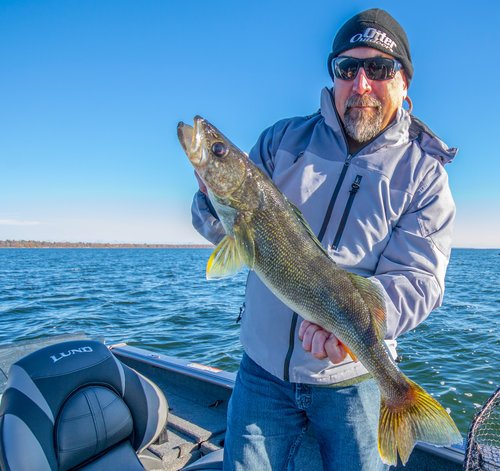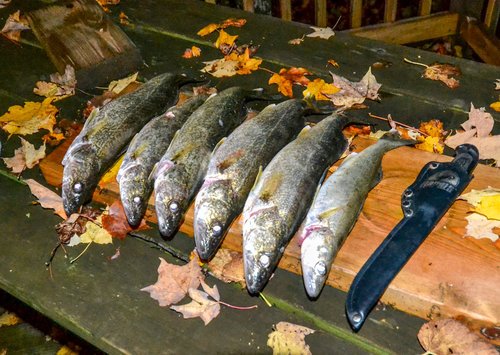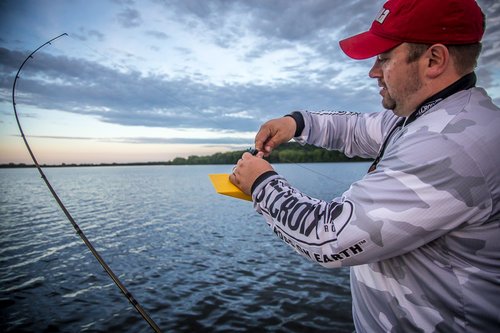The word “transitions” may be one of the more overused terms in fishing today. We hear about mud-to-sand or sand-to-rock transitions, seasonal transitions, and bait transitions; to the point where the word tends to lose its meaning. Yet, it’s highly appropriate when discussing fall walleyes, as there are few times of year where everything can change as quickly as it can in the fall. Which is why you’ll need to be flexible in your approach if you’re going to catch fish during this stage of the game.
“Transitions” to fall walleyes means fish that are behaving differently in terms of their location. Warm spells and resultant increased water temps push fish back to more summer areas, often deeper than 20 feet of water. Cold bouts, and especially prolonged cooler temperatures have the opposite effect they do in the summer. Walleyes push shallower, feed more aggressively, and should be welcomed by anglers, even if they need some bulkier clothes and more cold-weather stamina to handle it. Nothing kills a great fall bite like an “Indian Summer” that hits as water temps are slowly but surely otherwise dropping nicely.
If walleye locations change, it should be no surprise that the techniques to catch them should transition as well. After water temps are in the 50’s to stay, you can put away the leadcore gear you used all summer to target scattered deep fish, and look for fish to congregate. For the most part, cool weather concentrates fish, and often does it shallow where walleyes like to feed heavily. This is especially true with prolonged wind events that stack fish in shallow, predictable locations. Cool, windy days in the fall can see the biggest fish in any water body actively feeding during daylight conditions.
That’s all well and good, but rarely in the fall is any one water body locked into a specific depth and individual pattern that works well for walleyes most of the time. In reality, fish move at back and forth, with these depth migrations being gradual over time, with all kinds of smaller movements throughout the days and weeks of fall. They relate to water temperatures, light conditions, and major weather events. All of which sums up the truest sense of the term “fall transition,” meaning that walleyes in the fall are ALWAYS in flux.
Knowing that, then we have the challenge of determining details in targeting them. First and foremost, start shallow, and start aggressive. Crankbaits, both lipless and short-bodied shad diving baits, along with swimbaits, jig and plastic combinations, and even stickbaits are great choices for this type of fishing. Fish wind-driven points, rock piles, and ledges in as shallow as a few feet of water, and give it a good hour or more of your time. Make the fish prove to you that they’re not shallow before abandoning that bite, as when it’s on, it’s on in a big way.
Next, move to the first break, and let your electronics be your guide. Often, especially in clear bodies of water, fall transition fish will move below the edge of the first pronounced drop-off from shore during the day, still feeding occasionally, while waiting to push to nearby shallows for a night-time feeding session. These fish may require a bit more attention and subtlety, and large, live minnows are a great presentation for them. Free-swim a big chub behind ample weight on a larger than average rigging hook, and wait for the thump-thump of the minnow to be interrupted by a “smash.” Pay the fish ample line and give it some time to get the bait in his mouth before setting the hook, and you’ll be surprised how well fall walleyes are into big minnows. With some patience, many minnows lost, and some practice, you’ll also be wondering how even eater-sized walleyes can eat these extremely large minnows.
If live-bait isn’t your game, it’s a great time to try Jigging Raps on these intermediate-depth fish. You’ve got the combination of concentrated, aggressive fish, along with a bit of distance between you and the fish, such that Jigging Raps really have the space to dive, dart, swing, and work their magic. I know more than a few anglers that fish this bite from 60 degree water temps all the way until lake ice-up.
Finally, if fall walleye locations are confounding you, and you haven’t found anything at shallow or intermediary depths, consider going back to what worked in the summer. This could be live bait rigging deep structure, or even pulling leadcore. A few years ago, I did really well pulling leadcore, at night, in 25 feet of water in October. The fish shouldn’t have been there, especially then, but they were and they ate. It could be due to warmer than average weather preceding your visit to the lake, exceptionally clear water, or a number of other factors including turnover, but know that you’ve always got the patterns from the previous weeks to fall back on.
Stay mobile, be flexible with your baits, and fish the fall walleye transition in order from shallow to the depths. Let the fish decide what they want and where they want it, then realize that each fall day can act like a new season altogether as you repeat the process with success.





